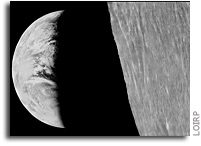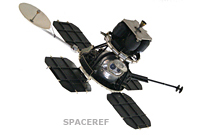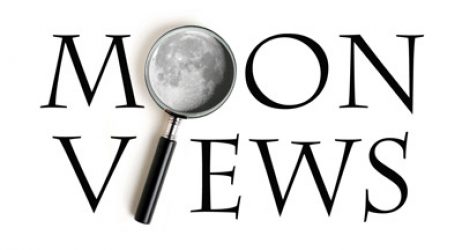 NASA Releases New Apollo 8 Earthrise Simulation Video
NASA Releases New Apollo 8 Earthrise Simulation Video
“NASA has issued a new visualization of the events leading to one of the iconic photographs of the 20th Century – Earth rising over the moon captured by the crew of the Apollo 8 mission. The photo known as Earthrise is the first color photograph of Earth taken by a person in lunar orbit. Earthrise is the cover photo of TIME’s Great Images of the 20th Century, and is the central photo on the cover of LIFE’s 100 Photographs That Changed the World.”
 NASA Google+ Hangout: New Visualization 45th Anniversary of Apollo 8 Viewing Earth from Space
NASA Google+ Hangout: New Visualization 45th Anniversary of Apollo 8 Viewing Earth from Space
“NASA will host a Google+ hangout at 2 p.m. EST Friday, Dec. 20, to unveil a new simulation of the events leading to the creation of “Earthrise,” one of the most iconic photographs of the 20th century. It was 45 years ago on Dec. 24, 1968, when Apollo 8 astronauts captured the photograph called “Earthrise,” the first color photograph of Earth taken by a person orbiting the moon.”
 The First Earthrise Image Makes a Trip Back To The Moon
The First Earthrise Image Makes a Trip Back To The Moon
“On 19 November 2013, the first image ever taken of the Earth rising over the Moon’s surface in 1966 was sent back to the Moon. This historic image, known as “Earthrise”, was taken on 23 August 1966 by NASA’s Lunar Orbiter 1. A full resolution electronic data file over 700 Mb in size containing this image was sent to the LADEE spacecraft currently in lunar orbit and then received back on Earth. The Earthrise image that was sent to LADEE was a restored and enhanced version created by the Lunar Orbiter Image Recovery Project (LOIRP) located at the Ames Research Park at Moffett Field, California. “
– How Life Magazine Revealed “Earthrise” in 1966
– Lunar Echoes on STS-130
 Nimbus II and Lunar Orbiter 1 Imagery: A New Look at Earth in 1966
Nimbus II and Lunar Orbiter 1 Imagery: A New Look at Earth in 1966
“… the National Snow and Ice Data Center, after seeing the work that the LOIRP team had done in potentially identifying the Antarctic sea ice in the Lunar Orbiter 1 Earthrise image, and recognizing the similarity between the raw data of the Nimbus and Lunar Orbiter data, provided a grant to the LOIRP team to process the Nimbus data into a modern format and to correct image artifacts that are common to both types of images. … On this day, in New York City, just over the Earth’s limb as seen from lunar orbit, the Beatles were preparing to play at Shea Stadium …”
– Beatles Legend Among Those Honored with Mercury Craters, NASA
Lunar Orbiter Image Recovery Project (LOIRP) Status 19 December 2013
 Dennis Wingo Status, end of day, December 19, 2013.
Dennis Wingo Status, end of day, December 19, 2013.
Well we are back in the saddle. Finished through tape W4-057 today. This puts us over half way. We have 50 Woomera LO-IV tapes to go now…. Lots of problems though with the spacecraft, lots of restarts of the image transfer process. More tomorrow then I am taking a week off for Christmas!
The First Earthrise Image Makes a Trip Back To The Moon
 On 19 November 2013, the first image ever taken of the Earth rising over the Moon’s surface in 1966 was sent back to the Moon.
On 19 November 2013, the first image ever taken of the Earth rising over the Moon’s surface in 1966 was sent back to the Moon.
This historic image, known as “Earthrise”, was taken on 23 August 1966 by NASA’s Lunar Orbiter 1. A full resolution electronic data file over 700 Mb in size containing this image was sent to the LADEE spacecraft currently in lunar orbit and then received back on Earth.
The NASA Lunar Laser Communication Demonstration (LLCD) system being tested during the LADEE mission allowed the image to be sent to and from the Moon in a fraction of the time required to originally send it back to Earth in 1966.
The Earthrise image that was sent to LADEE was a restored and enhanced version created by the Lunar Orbiter Image Recovery Project (LOIRP) located at the Ames Research Park at Moffett Field, California. This enhanced image was originally re-released to the public in November 2008.
Continue reading “The First Earthrise Image Makes a Trip Back To The Moon”
LOIRP Featured in The Atlantic
 NASA’s Original Lunar Images Are Housed in a Former McDonald’s, The Atlantic
NASA’s Original Lunar Images Are Housed in a Former McDonald’s, The Atlantic
“At an old McDonald’s at NASA Ames Research Park in Moffett Field, California, there are no Big Macs or chicken nuggets. Instead, there are reels and reels of original footage from the five lunar orbiters NASA launched in 1960. It’s all part of the Lunar Orbiter Image Recovery Project, an effort by Dennis Wingo and colleagues to digitize the old tapes. What it means is that the first image of Earth as seen from behind the moon is located in this former fast food joint, known colloquially as “McMoon’s.”
Lunar Orbiter Image Recovery Project (LOIRP) Status 18 December 2013
 Dennis WIngo: Status, end of day, December 18, 2013
Dennis WIngo: Status, end of day, December 18, 2013
Back to work! The new head works and Ken did all the adjustments and so we are back up and running! Late in the day however, and so I am only going to do one tape today as a verification step.
Doing W4-050 right now….
Will do as many as I can tomorrow to pick the ball back up.
A Closer Look at the Lunar Orbiter Spacecraft

This is one of the engineering flight spare Lunar Orbiter spacecraft on display at the National Air and Space Museum in Washington DC. Larger image

This diagram shows the major subsystems of the Lunar Orbiter spacecraft. Additional Photos below show the NASM exhibition from a variety of angles.
Continue reading “A Closer Look at the Lunar Orbiter Spacecraft”
High School Team Tackles Lunar Mystery

Members of the 2011-12 Lunar Exploration Team: L-R Abby Delawder, Tori Wilson, and Austen Beason
When the Lunar Reconnaissance Orbiter relayed images in 2011 of oddly striped boulders on the moon – some of them a dozen or more meters across – three students at Kickapoo High School in Springfield, Missouri, in search of a class science project decided to investigate. They joined a 2-semester research program through the SSERVI’s Center for Lunar Science and Exploration in Houston, Texas.
With mentor Georgiana Kramer, a planetary scientist there, the team has now netted a scientific paper. The Kickapoo Lunar Research Team spent several months trying to explain the stripes. Researchers had already floated several possibilities.
Kramer suspected that the light-colored layers were probably regolith, material blasted from impact craters elsewhere on the moon. But the students found that such debris accumulates much too slowly to account for the banding. Through their calculations, they arrived at a new explanation: The striping formed as molten material cooled deep within the moon’s crust. “I was surprised at the answer they came up with,” Kramer says. But the team has support for the theory: Some banded rocks on Earth form by a similar process, says team member Abby Delawder. “These banded rocks are nothing like any other rocks found on the moon’s surface,” she notes. “It’s clear they were blasted upward by an impact.”
Unlike the average high school project, this one appeared among graduate student posters at NASA’s annual Lunar Science Institute Forum in Mountain View, California, in 2012 and will be published in a forthcoming issue of the journal Icarus.
Posted by: Soderman/SSERVI Staff Source: SSERVI Team/ Ref: SCIENCE, VOL 342, DECEMBER 6 2013
Lunar Orbiter Image Recovery Project (LOIRP) Status 10 December 2013
 Dennis Wingo: Status December 10, 2013
Dennis Wingo: Status December 10, 2013
Thanks to Jim we may have found the reference I need so that it is not such an incredible pain to get the image numbers from the tapes. We will check it out tomorrow.
As of right now we are more than 1/3rd the way through the Woomera tapes for Lunar Orbiter IV, finishing up W4-038 before I leave today. These are all long captures so the number of tapes per day is fewer than what I would like, but it is getting all the data so it is good.
Looking at some of the LO-IV images, they have some absolutely outstanding data on them. Lunar Orbiter IV was the first images of the Moon that I worked with and they have always been some of the most dramatic….
Still trying to get to W4-070 by the end of the day Friday. Goals are good!. If we can do that or get close I should be finished with Woomera before next Friday and be started on the Goldstone captures!
Fun stuff to watch the scenes go by!
Lunar Orbiter Image Recovery Project Featured on “Raw Science”
“YouTube sensation Veritasium visits an abandoned McDonalds on the NASA Ames campus to reveal the first original lunar images, now being converted from film to digital media with the NASA LOIRP project. Watch the transformation of the original lunar Earth rise!”
Lunar Orbiter Image Recovery Project (LOIRP) Status 9 December 2013
 Dennis Wingo: Status December 9, 2013
Dennis Wingo: Status December 9, 2013
A bit of fun today. Been filling in the gap between W4-11 and W4-19 today with some images still foggy due to light getting into the camera system, not radiation as I first supposed (I still don’t know if I buy the explanation though).
During the recording of W4-17 I heard something that I had only heard once before on the tapes, a female voice. Here it is along with a bit more audio…
It takes several seconds for the audio to start in earnest and the female voice segment is short…
Crap, it won’t let me upload an mp3. Any suggestions?
Madrid Lunar Orbiter V Tapes

Dennis Wingo: Here are our Madrid Lunar Orbiter V tapes after their completion.! (h/t to James Snyder for catching the autocorrect snafu). Larger view
Lunar Orbiter Image Recovery Project (LOIRP) Status 6 December 2013
 Dennis Wingo Status, Friday evening, December 6th 2013.
Dennis Wingo Status, Friday evening, December 6th 2013.
Well got some tapes done today after skipping into the 20’s. Am going backward and will figure everything out on Monday. We are as far as W4-028 but did not do 11-18, 23….
Should have it back on track Monday. Not bad though, should be more than half way through Woomera for LO-IV by next Friday.
Dennis Wingo Lunar Orbiter Status, mid day Friday December 6, 2013
Frustrating week. First, we can’t find, or it does not exist, the same table (Photography and Operational Data Summary) that we have for Lunar Orbiter II, III, and V. That makes it a LOT harder to identify the images per their sequence numbers.
Second, the first ten Woomera tapes had two very noisy images and the rest of the tapes had nothing on them. There are some vague references to radiation fogging but I just bet they did not want that kind of information out there in the 1960’s before the Apollo missions. As an FYI, if the November 1972 flare had happened during the Apollo 17 mission we would have had three crispy astronauts.
I jumped all the way to W4-28 and found images, but still with some film fogging. In looking at the LPI images there are some pretty big gaps. Will be interesting to see what our image captures show.
I have run W4-25-28 now and am running backward until I hit the blank images. It is also going to be a pain in the rear to identify the images but will get it done.
